|
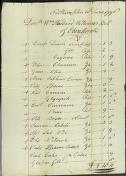
List of medicines bought from Ebenezer Hunt by William Stoddard Williams
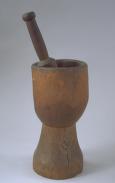
Mortar and Pestle
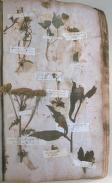
American Herbarium, Volume 1
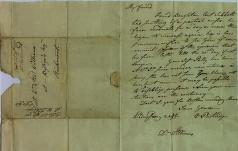
Letter to Dr. William Stoddard Williams from Oliver Partridge
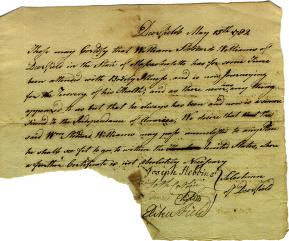
Letter from Deerfield Selectmen re: travel of William Stoddard Williams
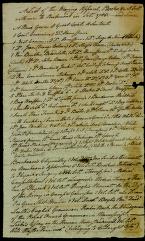
A List of Wearing Apparel, Books, &c. of William Stoddard Williams
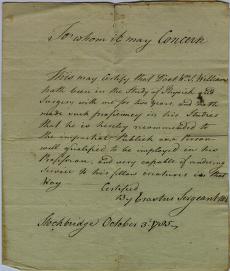
Medical proficiency certificate of William Stoddard Williams

Dr. William Stoddard Williams' description of a throat distemper diagnosis

"Historical Collections, being a General Collection of Interesting Facts, Traditions, Biographical Sketches, Anecdotes &c.",

"The Life and Age of Woman"

"The Young Ladies Book: A Manual of Elegant Recreations, Exercises, and Pursuits"
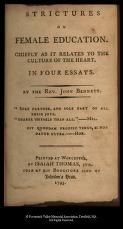
"Strictures on Female Education"
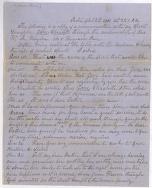
Communication with the Spirit of his dead daughter Jane Elizabeth Pierce

Silhouette of Persis Sheldon (1785-1804)

Excerpt of Dr. Joseph Goodhue's Diary

Letter to Widow Persis Hoyt Sheldon
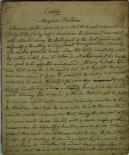
Medical Cases of Stephen West Williams: Angina Pectori.
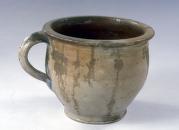
Chamber Pot
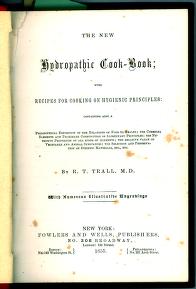
Graham Bread Recipe from "The New Hydropathic Cook-Book"

"Uroscopia."
|
Summary and Objective
What did western New Englanders do at the beginning of the 19th century when they were ill or injured? Who were the people who helped the sick and what were the tools they used to heal the patient? How did they learn the skills to be helpful as healers? This activity will encourage students to examine current ways of healing the sick and to compare our contemporary practices to those of New Englanders of the early 19th century. Students will understand that the manner in which a society takes care of the sick and injured reflects not only its scientific and technological achievement but also its attitudes about shared responsibility for one's neighbors.
Teaching Plan
Step 1.
Pre-Activity #1. Have a class discussion in which students will consider how modern people act when they become ill. •What are the most common home-based remedies? •What are some common maladies? •When do symptoms signal a trip to the doctor, clinic, or hospital? • Who are the medical helpers? • What skills do they have? •How does healthcare differ among Americans and why do these differences exist? •What equipment have the students seen medical workers use? •What role does money play in caring for the sick? (Chart comments from this discussion in 21st century row of the sample worksheet, which (along with vocabulary worksheets) is available at http://www.erving.com/sicknessandhealth/index.html ) or create your own chart to compare sickness and health in the 21st and 19th centuries.
Step 2.
Pre-Activity #2: Introduce the students to the medical items selected for this lesson. Using printed pictures of museum items, students will be challenged to find clues to illnesses, medical practices, and attitudes of the early 19th century. Limit the number of items a student may examine. What might be the function of a specific item? Students will write preliminary museum labels for the items.
Step 3.
American Centuries website: Children will freely explore their museum items. Using the "look closer", "show text", and "detailed info" buttons they will try to become experts on the objects. What questions does the description answer? What questions does it raise? Encourage children to find the meanings of new words and to record them on the vocabulary form. In the 19th century row of their charts, students should organize facts about various aspects of medical practice during the first half of the 19th century.
Step 4.
Students are encouraged to seek further information about early 19th century medical practices in library sources first and then on the internet. Possible resources include: Jack Larkin's "The Reshaping of Everyday Life 1790-1840" chapter two; encyclopedias; Rachel Baker, "The First Woman Doctor" (Elizabeth Blackwell); Bobbie Kalman, "Early Health and Medicine" (Early Settler Life Series); Don Nardo, "Vaccine" (Great Medical Discoveries); Jeanette Farrell, "Invisible Enemies: Stories of Infectious Disease"; Rob Desalle, "Epidemic! The World of Infectious Disease";Fred Powledge, "Pharmacy in the Forest: How Medicines are Found in the Natural World"; Teacher Reference: Robert and Michele Root-Bernstein, "Honey, Mud, Maggots, and Other Medical Marvels: The Science Behind Folk Remedies and Old Wives' Tales". Possible subjects to research: Smallpox, Dorthea Dix; Ether Day October 16, 1846, current US Healthcare crisis;
Step 5.
In small groups, students will compare contemporary and the historical data on their charts. They will then develop thoughtful comments about the how healing was and is practiced. Encourage them to think about what people tried to accomplish when treating disease and injuries. What were and are the individual contributions of various people who help the sick? What limited success historically and prevents us from providing high quality healthcare today?
Step 6.
Each group will present the larger group with at least two questions to discuss. The questions will help clarify how practices surrounding sickness and health tell something about the beliefs, knowledge, and attitudes of people in any historical period, including our own.
Step 7.
Post Activity: Each student will be asked to write a personal essay about a self-selected aspect of sickness and health. Each essay will start with an assertion that will be supported by historical and/or contemporary evidence.
|




